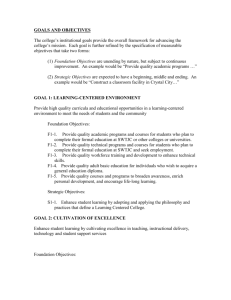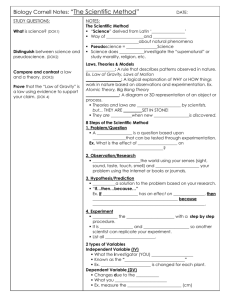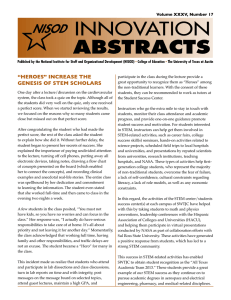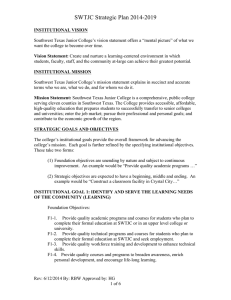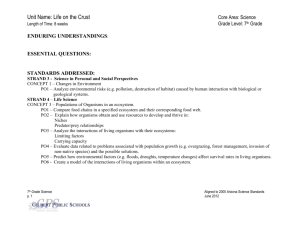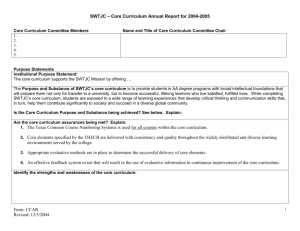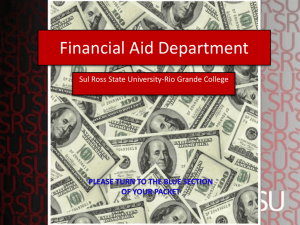SWTJC Planning Structure 2011-2015
advertisement
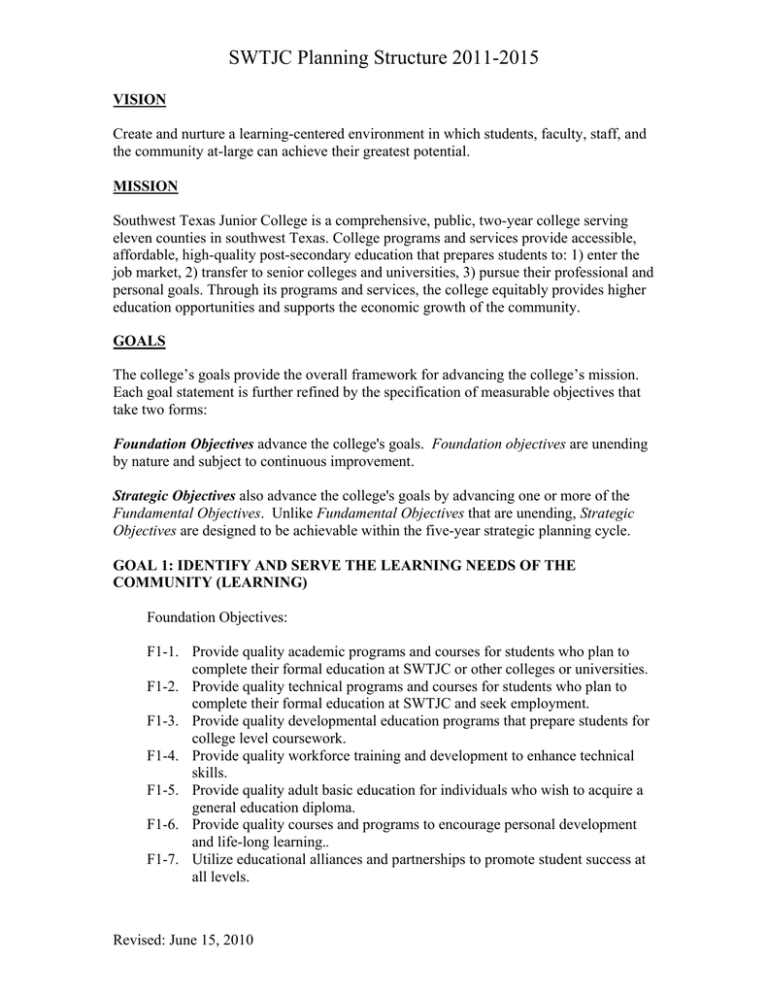
SWTJC Planning Structure 2011-2015 VISION Create and nurture a learning-centered environment in which students, faculty, staff, and the community at-large can achieve their greatest potential. MISSION Southwest Texas Junior College is a comprehensive, public, two-year college serving eleven counties in southwest Texas. College programs and services provide accessible, affordable, high-quality post-secondary education that prepares students to: 1) enter the job market, 2) transfer to senior colleges and universities, 3) pursue their professional and personal goals. Through its programs and services, the college equitably provides higher education opportunities and supports the economic growth of the community. GOALS The college’s goals provide the overall framework for advancing the college’s mission. Each goal statement is further refined by the specification of measurable objectives that take two forms: Foundation Objectives advance the college's goals. Foundation objectives are unending by nature and subject to continuous improvement. Strategic Objectives also advance the college's goals by advancing one or more of the Fundamental Objectives. Unlike Fundamental Objectives that are unending, Strategic Objectives are designed to be achievable within the five-year strategic planning cycle. GOAL 1: IDENTIFY AND SERVE THE LEARNING NEEDS OF THE COMMUNITY (LEARNING) Foundation Objectives: F1-1. Provide quality academic programs and courses for students who plan to complete their formal education at SWTJC or other colleges or universities. F1-2. Provide quality technical programs and courses for students who plan to complete their formal education at SWTJC and seek employment. F1-3. Provide quality developmental education programs that prepare students for college level coursework. F1-4. Provide quality workforce training and development to enhance technical skills. F1-5. Provide quality adult basic education for individuals who wish to acquire a general education diploma. F1-6. Provide quality courses and programs to encourage personal development and life-long learning.. F1-7. Utilize educational alliances and partnerships to promote student success at all levels. Revised: June 15, 2010 SWTJC Planning Structure 2011-2015 Strategic Objectives: S1-1. Establish a formal ESL program. (F1-3)1 S1-2. Increase the number of developmental education students who become college-ready, complete the gateway course, and do it in less time2. (F1-3) S1-3. Increase the number of students achieving 15/30 credits, core completers, certificates and degrees, and transfers with 30+ credits. (F1-1 & F1-2) S1-4. Increase the number of students majoring and transferring in STEM areas. (F1-1) GOAL 2: CULTIVATE EXCELLENCE IN TEACHING, INSTRUCTIONAL DELIVERY, STUDENT SERVICES, AND ADMINISTRATIVE SUPPORT (QUALITY) Foundation Objectives: F2-1. Provide access, equity, diversity, and quality in instructional programs and services to ensure that students can participate, progress, succeed, transfer and/or enjoy gainful employment. F2-2. Foster excellence in teaching, administration and services through professional development of faculty and staff. F2-3. Identify, encourage, recognize, and reward success. F2-4. Provide quality services that recognize, support, and enhance student success. F2-5. Ensure quality services and instruction in all distance learning modalities. F2-6. Enhance the effectiveness of technology as it affects student learning and college administration. F2-7. Promote an environment in which community members are informed, included, and their input is valued and respected. F2-8. Provide sufficient facilities and equipment to support the college’s programs and services Strategic Objectives: S2-1. Improve student services in advising and counseling; at-risk management; enrollment management3; and registration. (F2-4) S2-2. Increase the quality and number of programs and courses offered using distance learning modalities. (F2-1) S2-3. Improve the quality of student learning by providing increased access to tutoring, supplemental instruction, advising, and counseling to distance learning students. (F2-5) 1 This strategic object is associated with Foundation Objective F2-4 and advances Goal 2. As an example, the objective would include the identification and support of the “almost there student.” 3 Includes recruitment and matriculation (STEM/GED/WF/dual-credit/non-traditional students), late start, flex entry, scheduling and transfer. 2 Revised: June 15, 2010 SWTJC Planning Structure 2011-2015 S2-4. Make more effective use of the ERP (Datatel) system. (F2-6) S2-5. Upgrade IT infrastructure to support the increased utilization of the ERP (Datatel) system, distance learning modalities, and inter/intra-campus communication. (F2-8) S2-6. Address facility needs on Del Rio, Eagle Pass, Uvalde campuses (classroom, office space, and Cosmetology space). (F2-8) S2-7. Address deferred maintenance issues in all facilities (HVAC, lighting, painting, energy consumption, ADA compliance, and dormitories). (F2-8) S2-8. Review and enhance the system of professional and staff evaluation to ensure that it supports Foundation and Strategic Objectives. (F2-4) GOAL 3: PROVIDE RELIABLE AND SUSTAINABLE RESOURCES AND FUNDING FOR THE COLLEGE (EFFICIENCY) Foundation Objectives: F3-1. Develop and deepen partnerships with businesses, public officials, alumni, community-based organizations, and other constituents in order to increase the efficient and effective use of human and capital resources. F3-2. Identify, develop, and acquire grants to advance the strategic objectives of the college. F3-3. Identify and utilize areas of operational efficiency. F3-4. Evaluate resources and funding to assure that they effectively and efficiently support the overall mission of the college. Strategic Objectives: S3-1. Develop and submit a Title V Cooperative Grant with Rio Grande College (SRSU). (F3-1) S3-2. Develop and submit a minimum of four grants per year to federal, state, and private foundations. (F3-2) S3-3. Develop and implement a plan that reduces energy consumption by 5 per cent. (F3-3) S3-4. Develop and implement a plan that expands current library services to meet the standards and guidelines for libraries in higher education as set forth by the American Library Association. (F3-4) Revised: June 15, 2010
